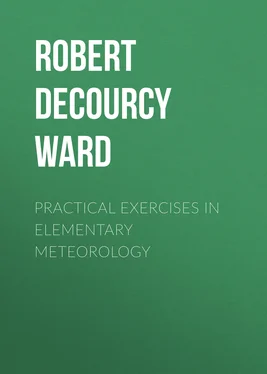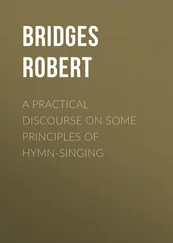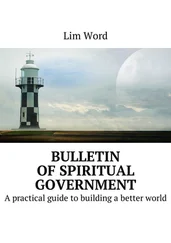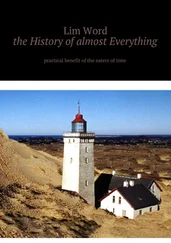Robert DeCourcy Ward - Practical Exercises in Elementary Meteorology
Здесь есть возможность читать онлайн «Robert DeCourcy Ward - Practical Exercises in Elementary Meteorology» — ознакомительный отрывок электронной книги совершенно бесплатно, а после прочтения отрывка купить полную версию. В некоторых случаях можно слушать аудио, скачать через торрент в формате fb2 и присутствует краткое содержание. Жанр: foreign_antique, Физика, foreign_edu, на английском языке. Описание произведения, (предисловие) а так же отзывы посетителей доступны на портале библиотеки ЛибКат.
- Название:Practical Exercises in Elementary Meteorology
- Автор:
- Жанр:
- Год:неизвестен
- ISBN:нет данных
- Рейтинг книги:4 / 5. Голосов: 1
-
Избранное:Добавить в избранное
- Отзывы:
-
Ваша оценка:
- 80
- 1
- 2
- 3
- 4
- 5
Practical Exercises in Elementary Meteorology: краткое содержание, описание и аннотация
Предлагаем к чтению аннотацию, описание, краткое содержание или предисловие (зависит от того, что написал сам автор книги «Practical Exercises in Elementary Meteorology»). Если вы не нашли необходимую информацию о книге — напишите в комментариях, мы постараемся отыскать её.
Practical Exercises in Elementary Meteorology — читать онлайн ознакомительный отрывок
Ниже представлен текст книги, разбитый по страницам. Система сохранения места последней прочитанной страницы, позволяет с удобством читать онлайн бесплатно книгу «Practical Exercises in Elementary Meteorology», без необходимости каждый раз заново искать на чём Вы остановились. Поставьте закладку, и сможете в любой момент перейти на страницу, на которой закончили чтение.
Интервал:
Закладка:
Temperature and Precipitation.—Does a shower or a rainstorm in the hotter months affect the temperature of the air in any way? How? In the winter does the temperature show any changes before a snowstorm? Is it usually warmer or colder then than a day or two before the storm and the day after? Is it usually uncomfortably cold during a snowstorm? Are rainy spells in the spring and the autumn months cooler or warmer than clear dry weather?
Part II.—Instrumental Observations
CHAPTER II.
ELEMENTARY INSTRUMENTAL OBSERVATIONS
The non-instrumental observations, suggested in the preceding chapter, prepare the way for the more exact records of the weather elements which are obtainable only by the use of instruments. The non-instrumental records are not to be entirely given up, even after the instrumental work and the weather-map exercises have begun, but should be continued throughout the course. Notes on the forms and changes of clouds, on the times of beginning and ending, and on the character of the precipitation, as outlined in the last chapter, and other observations made without the use of instruments, are an essential part of even the most advanced meteorological records.
The simpler instruments are the ordinary thermometer , the wind vane , the rain gauge , and the mercurial barometer (in a modified form). Observations with these instruments, although of a simple character, can be made very useful. The advance over the non-instrumental observations, which latter may be termed observations of sensation , is a decided one. In place of the vague and untrustworthy statements concerning hot and cold, warm and cool days, we now have actual degrees of temperature to serve as a basis for comparison of day with day or month with month. The measurements of rain and snowfall enable us to study the amounts brought in different storms, the average precipitation of the various months, etc. The important facts of change of pressure now become known, and also the relation of these changes to the weather. Just as we have, in the earlier work, become familiar with our typical weather changes and types, so we shall now have our eyes opened to the actual values of the temperatures and precipitation connected with these changes.

Fig. 1.
The ordinary thermometer(Greek: heat measure ), the most commonly used and most widely known of all meteorological instruments, was in an elementary form known to Galileo, and was used by him in his lectures at the University of Padua during the years 1592 to 1609. Thermometers enable us to measure the temperatures of different bodies by comparison with certain universally accepted standards of temperature. These standards are the freezing and boiling points of distilled water. In its common form the thermometer consists of a glass tube, closed at the top, and expanding at its lower end into a hollow spherical or cylindrical glass bulb. This bulb and part of the tube are filled with mercury or alcohol. As the temperature rises, the liquid expands, flows out of the bulb, and rises in the tube. As the temperature falls, the mercury or alcohol contracts, and therefore stands at a lower level in the tube. In order that the amount of this rise or fall may be accurately known, some definite scale for measurement must be adopted. The scale commonly used in this country owes its name to Fahrenheit (born in Danzig in 1686; died in 1736), who was the first to settle upon the use of mercury as the liquid in thermometers, and also the first definitely to adopt two fixed points in graduating the scale. The division of this scale into 180° between the freezing point (32°) and the boiling point (212°) seems to have been taken from the graduation of a semicircle. Fahrenheit was a manufacturer of all sorts of physical apparatus, and it has been thought probable that he had some special facilities for dividing his thermometer tubes into 180 parts. Mercury is most commonly used as the liquid in thermometers, because it readily indicates changes of temperature, and because over most of the world the winter cold is not sufficient to freeze it. The freezing point of mercury is about 40° below zero (-40° F.). Alcohol, which has a much lower freezing point, is therefore used in thermometers which are to be employed in very cold regions. Alcohol thermometers must, for instance, be used in Northern Siberia, where the mean January temperature is 60° below zero.
The temperature which meteorologists desire to obtain by the ordinary thermometer is the temperature of the free air in the shade . In order that thermometers may indicate this temperature, they must, if possible, be placed in an open space where there is an unobstructed circulation of the air, and they must be protected from the direct rays of the sun. They are, therefore, usually exposed inside of a cubical enclosure of wooden lattice work, in an open space away from buildings, and at a height of 4 to 10 feet above the ground, preferably a grass-covered surface. This enclosure is called the shelter , and its object is to screen the instrument from the direct and reflected sunshine, to allow free circulation of air around the bulb, and to keep the thermometer dry. Sometimes the shelter, instead of being in an open space on the ground, is built on the roof or against the north wall of a building, or outside of one of the windows. Fig. 2 shows an ordinary shelter.
A still simpler method of exposure is described in the “Instructions for Voluntary Observers” (United States Weather Bureau, 1892) as follows: “Select a north window, preferably of an unoccupied room, especially in winter. Fasten the blinds open at right angles to the wall of the house. Fasten a narrow strip 3 inches wide across the window outside, and from 8 to 12 inches from the window-pane. To this fasten the thermometers.” If none of these methods of sheltering the instrument is feasible, the thermometer may be fastened to the window frame, about a foot from the window, and so arranged that it can be read from the inside of the room without opening the window.
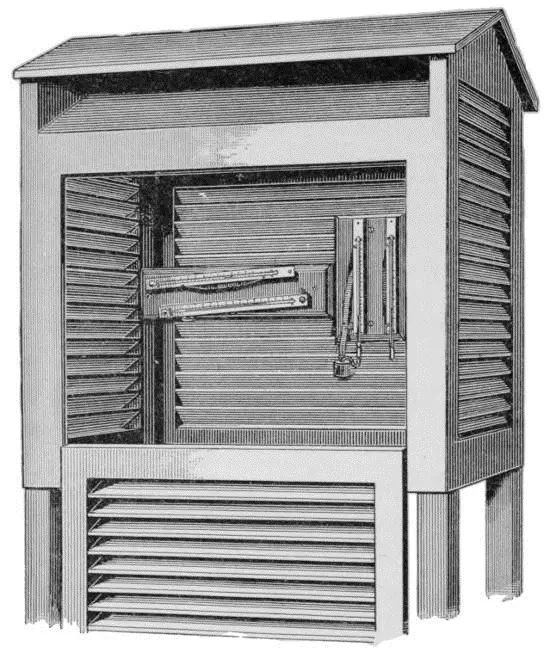
Fig. 2.
Readings of the thermometer, to the nearest degree of temperature indicated on the scale by the top of the mercury column, are to be made at the regular observation hours, and are to be entered in your record book. Temperatures below zero are preceded by a minus sign (-). A table similar to that suggested towards the close of the last chapter (p. 8) may be used in keeping these instrumental records, except that actual thermometer readings can now be entered in the column headed “Temperature,” instead of using only the general terms warm , cold , chilly , etc. This is a great gain. You will now be able to give fairly definite answers to many of the questions asked in Chapter I. Answer these questions with the help of your thermometer readings, as fully as you can.
The greater part of the Temperate Zone, in which we live, is peculiar in having frequent and rapid changes of temperature, not only from season to season, but from day to day, and during a single day. In winter, we are apt to have a warm wind immediately after a spell of crisp cold weather. In summer, cloudy, cool days come as a sudden relief when we have been suffering from intense heat, with brilliant sunshine.
These changes give a variety to our climate which is, on the whole, very beneficial to man. The North Temperate Zone, with strong seasonal changes in temperature and weather, is the zone of the highest civilization and of the greatest energy of man. In the Torrid Zone the changes of temperature are, as a whole, small. There is no harsh winter. The climate is monotonous and deadening, rather than enlivening. Man finds it easy to live without much work, and the inhabitants of the Torrid Zone have not, as a rule, advanced far in the scale of civilization.
Читать дальшеИнтервал:
Закладка:
Похожие книги на «Practical Exercises in Elementary Meteorology»
Представляем Вашему вниманию похожие книги на «Practical Exercises in Elementary Meteorology» списком для выбора. Мы отобрали схожую по названию и смыслу литературу в надежде предоставить читателям больше вариантов отыскать новые, интересные, ещё непрочитанные произведения.
Обсуждение, отзывы о книге «Practical Exercises in Elementary Meteorology» и просто собственные мнения читателей. Оставьте ваши комментарии, напишите, что Вы думаете о произведении, его смысле или главных героях. Укажите что конкретно понравилось, а что нет, и почему Вы так считаете.
